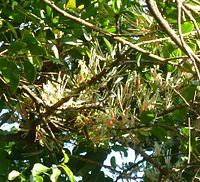| Hairy mistletoe | |
|---|---|

| |
| E. dregei on a Croton sylvaticus host at Amanzimtoti, South Africa | |
| Scientific classification | |
| Kingdom: | Plantae |
| Clade: | Tracheophytes |
| Clade: | Angiosperms |
| Clade: | Eudicots |
| Order: | Santalales |
| Family: | Loranthaceae |
| Genus: | Erianthemum |
| Species: | E. dregei |
| Binomial name | |
| Erianthemum dregei (Eckl. & Zeyh.) Tiegh. | |
| Synonyms | |
| |
Erianthemum dregei is a species of parasitic plant in the family Loranthaceae, and is commonly known as the hairy mistletoe or wood flower.
Distribution and habitat
These plants are native to Africa and are parasitic on a large number of tree species in higher rainfall areas from the Eastern Cape of South Africa, through KwaZulu-Natal, Eswatini and Mpumalanga, to East Africa, as far as northern Ethiopia. They are also found in southern Angola.
Description


A branched parasitic shrub with spreading or pendent stems, forming clumps of up to 2m x 1.5m. The leaves are leathery and hairless, usually alternate (sometimes opposite), with conspicuous side veins. The growing points are velvety brown. The flowers are massed in small clusters and are densely hairy, pale yellowish-green and sometimes flushed orange to pink. The fruit is an orange to bright red berry, 10–15 mm in size. Erianthemum dregei shows great variation across its range.
Human uses
Erianthemum dregei is used in African traditional medicine to treat stomach complaints in children and cattle.
Ecological significance
The flowers and fruit attract birds. The leaves are eaten by the larvae of Mylothris agathina.
References
- ^ E. Pooley (1998). A Field Guide to Wild Flowers of KwaZulu-Natal and the Eastern Region. Natal Flora Publications Trust. ISBN 978-0-620-21500-8.
- ^ Hyde, M.A., Wursten, B.T. & Ballings, P. (2011). Flora of Zimbabwe: Species information: Erianthemum dregei. http://www.zimbabweflora.co.zw/speciesdata/species.php?species_id=120950, retrieved 28 November 2011.
- ^ JSTOR PLANT SCIENCE: Entry for ERIANTHEMUM dregei (Eckl. & Zeyh.) Tiegh.:http://plants.jstor.org/flora/ftea004152, retrieved 28 November 2011.
- Woodhall, Steve (2005). Field Guide to Butterflies of South Africa. Cape Town, South Africa: Struik. ISBN 978-1-86872-724-7.
External links
- Dressler, S.; Schmidt, M. & Zizka, G. (2014). "Erianthemum dregei". African plants – a Photo Guide. Frankfurt/Main: Forschungsinstitut Senckenberg.
| Taxon identifiers | |
|---|---|
| Erianthemum dregei |
|
| Loranthus dregei | |